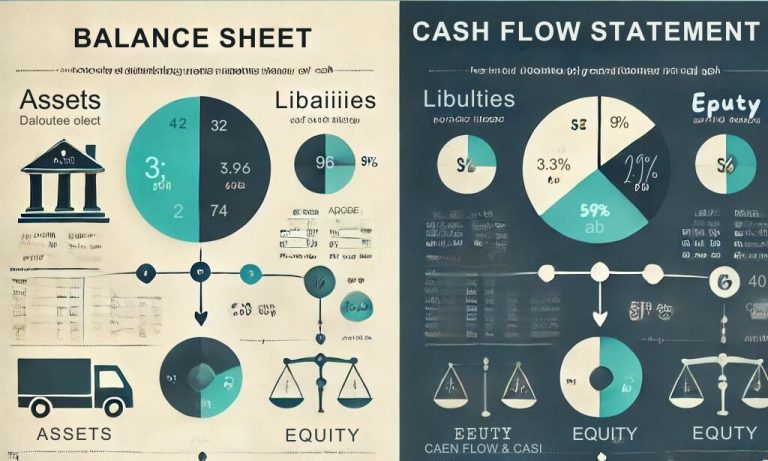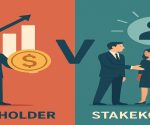Understanding the difference between a balance sheet and a cash flow statement is critical to effective financial management. These interconnected financial statements play distinct roles. A balance sheet provides an account of the entity’s financial position at one given time. This includes assets, liabilities, and equity. A cash flow statement outlines the cash in and out of the business over time, focusing on operating, investing, and financing activities. All these statements work together to give a fair view of the financial health of an organization.
What is Balance Sheet?
A balance sheet is a very important financial statement that gives an idea about an organization’s financial position at a specific point in time. Technically, it is a comprehensive summary of what the organization owns (assets), what it owes (liabilities), and the residual interest of the owners or shareholders (equity). This statement is based on the foundation provided by the fundamental accounting equation, ensuring that the balance sheet is always balancing.
Assets = Liabilities + Equity
| Particulars | Note No. | Amount as per Current Year | Amount as per Previous Year |
| I. EQUITY AND LIABILITY | |||
| 1. Shareholders’ Funds | xxx | xxx | |
| 2. Share Application Money Pending Allotment | xxx | xxx | |
| 3. Non-current Liabilities | xxx | xxx | |
| 4. Current Liabilities | xxx | xxx | |
| TOTAL | XXXX | XXXX | |
| II. ASSETS | |||
| 1. Non-current Assets | xxx | xxx | |
| 2. Current Assets | xxx | xxx | |
| TOTAL | XXXX | XXXX |
Key Components of a Balance Sheet
A balance sheet provides a snapshot of a company’s financial position at a given point in time, detailing assets, liabilities, and equity. Here is an in-depth explanation of its key components:
- Assets: These are the resources owned by the organization that have economic value and are expected to generate future benefits. Assets are categorized into current assets (easily convertible into cash within a year, such as cash, accounts receivable, and inventory) and non-current assets (long-term resources like property, plant, equipment, and intangible assets).
- Liabilities: These represent the organization’s obligations or debts owed to external parties. Like assets, liabilities are divided into current liabilities (due within a year, such as accounts payable and short-term loans) and non-current liabilities (long-term obligations, such as bonds payable and deferred tax liabilities).
- Equity: This section reflects the shareholder’s or owner’s residual interest in the company after liabilities have been deducted from assets. It includes components like common stock, retained earnings, and reserves.
What is Cash Flow Statement?
A cash flow statement is a key financial statement that provides detailed insights into an organization’s cash inflows and outflows during a specific accounting period. It is an essential tool for understanding how a business generates and uses its cash resources, offering a clear picture of its liquidity and financial health. By focusing solely on cash transactions, the statement excludes non-cash accounting elements, such as depreciation, ensuring an accurate representation of actual cash availability.
Components of Cash Flow Statement
A cash flow statement classifies all cash inflows and outflows into three distinct categories, each providing valuable insights into specific aspects of a company’s financial activities:
- Operating Activities: This section details cash flows related to the organization’s core business operations. It includes cash generated from sales of goods or services and cash paid for expenses like salaries, taxes, and supplier payments. Adjustments are often made for non-cash items such as depreciation or changes in working capital to reflect true cash flow from operations.
- Investing Activities: Cash flows in this category arise from the purchase and sale of long-term assets and investments. Examples include cash spent on acquiring property, plant, and equipment, or proceeds from selling investments. This section reflects the organization’s strategic investments in its future growth and operational capacity.
- Financing Activities: This segment captures cash flows related to funding the business, including transactions with lenders and shareholders. It includes activities such as borrowing or repaying loans, issuing equity, or distributing dividends. Financing activities indicate how the organization raises and repays capital to sustain its operations.
Differences Between Balance Sheet & Cash Flow Statement
Both the balance sheet and the cash flow statement are crucial but serve different purposes. The balance sheet provides a snapshot of an organization’s financial position, detailing assets, liabilities, and equity at a specific point in time, while the cash flow statement tracks cash inflows and outflows over a period, focusing on liquidity and cash management.
| Aspect | Balance Sheet | Cash Flow Statement |
| Definition | The balance sheet is a financial statement that provides a snapshot of a company’s financial position at a specific point in time. It lists assets, liabilities, and shareholders’ equity, showing what the company owns and owes. | The cash flow statement is a financial report that outlines the cash inflows and outflows over a given period. It focuses solely on actual cash transactions, divided into operating, investing, and financing activities. |
| Purpose | The primary purpose of the balance sheet is to present the company’s overall financial stability by detailing its resources (assets) and obligations (liabilities), as well as the equity held by shareholders. | The cash flow statement’s main purpose is to track the movement of cash into and out of the business, ensuring that the company has enough liquidity to meet its short-term and long-term needs. |
| Components | It comprises three key sections: Assets, which include current and non-current resources; Liabilities, both short-term and long-term obligations; and Shareholders’ Equity, which represents the owners’ stake in the business. | It is divided into three activities: Operating Activities (cash from core business operations), Investing Activities (cash from investments and asset purchases or sales), and Financing Activities (cash from borrowing or equity financing). |
| Time Frame | The balance sheet is static and reflects the financial position at a single point in time, such as the end of a financial quarter or year. | The cash flow statement is dynamic, covering cash transactions over a period, such as a month, quarter, or year. It provides a flow-based view of financial performance. |
| Focus | The balance sheet focuses on accounting principles, including accruals and deferrals. It captures resources and obligations, even if no cash transaction has occurred. For example, it includes accounts receivable and payable. | The cash flow statement focuses exclusively on actual cash movements, ignoring non-cash transactions like depreciation or accrued expenses. It reflects liquidity rather than profitability. |
| Insights Provided | Provides insights into a company’s financial structure, liquidity (current ratio, working capital), and long-term solvency (debt-to-equity ratio). | Offers insights into the company’s ability to generate cash, pay debts, reinvest in operations, and manage financial stability during cash flow fluctuations. |
| Link to Financial Health | Indicates long-term financial health and the ability to grow sustainably by leveraging assets and managing liabilities effectively. | Indicates short-term financial health by highlighting whether the company has enough cash to cover day-to-day operations and unforeseen expenses. |
Conclusion
The essential aspect of understanding the balance sheet versus the cash flow statement distinction is for a comprehensive view of financial health. A balance sheet focuses on the stability of a company at any specific point in time, but a cash flow statement establishes liquidity and operational effectiveness over time. Together, they form a robust foundation for financial decision-making.
Balance Sheet vs Cash Flow Statement FAQs
Why is the balance sheet important for financial analysis?
A balance sheet provides a detailed view of assets, liabilities, and equity which help stakeholders assess the organization’s financial health and stability.
What does the cash flow statement reveal that the balance sheet does not?
A cash flow statement captures the real cash inflow and outflow of the business, with a focus on its liquidity and solvency, which the balance sheet does not directly touch on.
Is it possible for a company to have a strong balance sheet but weak cash flow?
Yes, the simple fact is that a company can have adequate assets but still face problems of liquidity because of bad cash flow management.
How are the balance sheet and cash flow statement interrelated?
The cash flow statement begins with the opening cash balance (from the balance sheet) and reconciles changes to arrive at the closing cash balance.
What is the primary difference between the two statements?
The main difference is in emphasis: the balance sheet is concerned with reporting the financial position, while the cash flow statement is concerned with monitoring liquidity and cash management.


